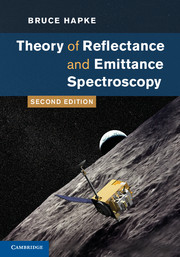Book contents
- Frontmatter
- Contents
- Acknowledgments
- 1 Introduction
- 2 Electromagnetic wave propagation
- 3 The absorption of light
- 4 Specular reflection
- 5 Single-particle scattering: perfect spheres
- 6 Single-particle scattering: irregular particles
- 7 Propagation in a nonuniform medium: the equation of radiative transfer
- 8 The bidirectional reflectance of a semi-infinite medium
- 9 The opposition effect
- 10 A miscellany of bidirectional reflectances and related quantities
- 11 Integrated reflectances and planetary photometry
- 12 Photometric effects of large-scale roughness
- 13 Polarization of light scattered by a particulate medium
- 14 Reflectance spectroscopy
- 15 Thermal emission and emittance spectroscopy
- 16 Simultaneous transport of energy by radiation and thermal conduction
- Appendix A A brief review of vector calculus
- Appendix B Functions of a complex variable
- Appendix C The wave equation in spherical coordinates
- Appendix D Fraunhofer diffraction by a circular hole
- Appendix E Table of symbols
- Bibliography
- Index
6 - Single-particle scattering: irregular particles
Published online by Cambridge University Press: 05 January 2012
- Frontmatter
- Contents
- Acknowledgments
- 1 Introduction
- 2 Electromagnetic wave propagation
- 3 The absorption of light
- 4 Specular reflection
- 5 Single-particle scattering: perfect spheres
- 6 Single-particle scattering: irregular particles
- 7 Propagation in a nonuniform medium: the equation of radiative transfer
- 8 The bidirectional reflectance of a semi-infinite medium
- 9 The opposition effect
- 10 A miscellany of bidirectional reflectances and related quantities
- 11 Integrated reflectances and planetary photometry
- 12 Photometric effects of large-scale roughness
- 13 Polarization of light scattered by a particulate medium
- 14 Reflectance spectroscopy
- 15 Thermal emission and emittance spectroscopy
- 16 Simultaneous transport of energy by radiation and thermal conduction
- Appendix A A brief review of vector calculus
- Appendix B Functions of a complex variable
- Appendix C The wave equation in spherical coordinates
- Appendix D Fraunhofer diffraction by a circular hole
- Appendix E Table of symbols
- Bibliography
- Index
Summary
Introduction
The scattering of electromagnetic radiation by perfect, uniform, spherical particles was described in Chapter 5. However, such particles are rarely found in nature. Most pulverized materials, including planetary regoliths, volcanic ash, laboratory samples, and industrial substances, have particles that are irregular in shape, have rough surfaces, and are not uniform in either structure or composition. Even the liquid droplets in clouds are not perfectly spherical, and they contain inclusions of submicroscopic particles around which the liquid has condensed, so that they are not perfectly uniform. At the present state of our computational and analytical capabilities it is possible to find exact solutions of scattering by such particles only by the expenditure of considerable computer time and memory (to say nothing of the effort of writing detailed programs), so that approximate models remain extremely useful.
The objective of any model of single-particle scattering is to relate the microscopic properties of the particle (its structure and complex refractive index) to the macroscopic properties (the scattering and extinction efficiencies and the phase function) that, in principle, can be measured by an appropriate scattering experiment. This chapter describes a variety of models that have been proposed to describe the scattering of light by irregular particles. This is not an exhaustive survey; rather, it is a commentary on those models that are most often encountered in remote-sensing applications or that offer some particular insight into the problem.
The organization of this chapter is as follows. First, the quantities defined in Chapter 5 for spherical particles are extended to particles that are nonspherical in shape.
- Type
- Chapter
- Information
- Theory of Reflectance and Emittance Spectroscopy , pp. 100 - 144Publisher: Cambridge University PressPrint publication year: 2012



